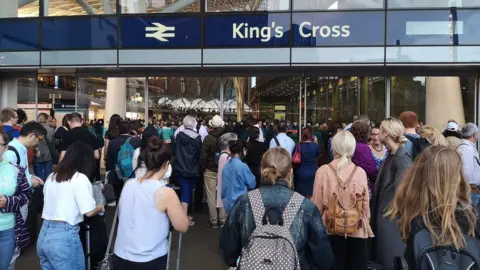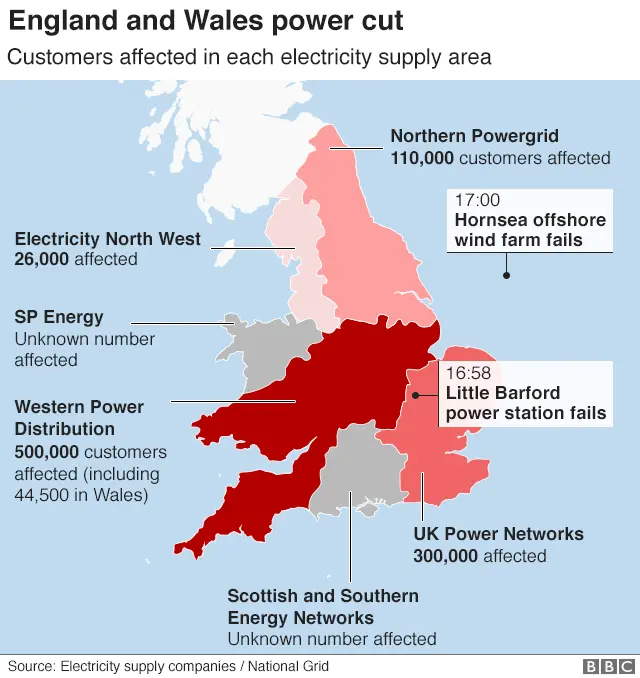UK power cut: Why it caused so much disruption
 PA Media
PA MediaWhen two power stations disconnected from the National Grid for 15 minutes, rail travellers ended up stranded for hours.
How did it happen and why did it have such a big impact?
Why did the power stations fail?
It started with a routine blip - the gas-fired power station at Little Barford in Bedfordshire shut down at 16:58 BST due to a technical issue.
Then, a second power station, the new Hornsea offshore wind farm, also "lost load" - meaning the turbines were still moving, but power was not reaching the grid.
Two power stations shutting down almost simultaneously is "a very rare event", says David Hunter, energy analyst at Schneider Electric. "That took the National Grid by surprise."
He says an investigation into the causes may show that the two failures were "coincidental and unconnected", adding there have been occasions when two generators shut down independently before.
But he said a power station dropping off the grid can also create a "domino effect", where other generators buckle under the strain of making up for the shortfall in power.
Was wind power to blame?
Despite high winds on Friday, National Grid's director of operations Duncan Burt said the shutdowns had "nothing to do with changes in wind speed or the variability of wind".
Experts say there is no reason to think wind farms are more likely than other generators to disconnect from the grid.
But they say renewable energy such as wind power can create problems for the National Grid.
"Gas and coal-fired power stations have more flexibility. When one drops off it's easier for another to pick up the slack," Mr Hunter says.
Wind power is less effective as a "shock absorber" to shifts in supply and demand, according to the energy analyst.
He said National Grid was designing systems that were intended to cope with increasing amounts of renewable energy and those associated problems - but it was "too early to say" if it was a factor in Friday's power cuts.
Why did parts of the grid shut down?
The National Grid has to maintain an electrical frequency of 50Hz. When supply falls and demand remains high, the frequency drops - to 48.9Hz in this case, well below the accepted level.
The wrong frequency can be dangerous, says Mr Hunter, causing damage to the UK electricity infrastructure.
National Grid says its automated systems kick in to stop any damage, chiefly by cutting off parts of the grid to reduce overall demand.


But Lord Adonis, a former chairman of the National Infrastructure Commission, has questioned the design of the automated systems if one of the first things to be affected was the national transport system.
He says National Grid needs to ensure "when something like this happens - two power stations going down - it doesn't lead to the whole country grinding to a halt".
Why did it take so long to fix the problems?
The blackouts were resolved relatively quickly. The power stations were back in action after 15 minutes and National Grid says local power suppliers were meeting demand by 17:40 BST.
But that is little comfort to passengers like Lawal Brown, who boarded a Thameslink train at Stevenage at 16:45. It took nearly six hours before he was evacuated onto another train and many more before he made it home.
Network Rail said the blackout affected signalling systems and power supply equipment across a large part of the rail system, but backup systems stepped in.
That still meant some delays because of safety requirements, says Nick King, network services director for Network Rail.
But he says further difficulties were caused by a "major systems failure" on "one particular fleet of trains". Thameslink has acknowledged that its trains required a technician to restart them after the power cut.
Mr King says this caused "significant disruption" in parts of the network, although Network Rail, train operators and police worked "flat out" to rescue stranded passengers.
